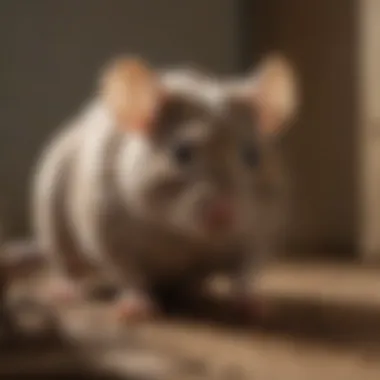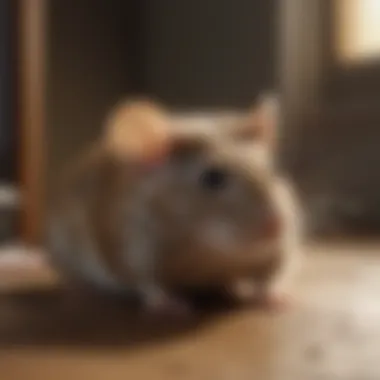Mastering the Art of Smart Mouse Elimination


Intro
Dealing with smart mice requires more than basic knowledge; it necessitates strategic thinking and detailed awareness. These rodents, often underestimated, display remarkable adaptability and intelligence. Understanding their behaviors and patterns is crucial for effective management. This guide walks you through identifying these pests, employing preventive measures, and exploring eco-friendly solutions.
Identification of Common Pests
Description of Common Pests
In residential and commercial environments, the most commonly encountered species of smart mice include the house mouse (Mus musculus), field mouse (Apodemus species), and sometimes the deer mouse (Peromyscus maniculatus). Each of these species shares characteristics that allow them to thrive in human habitats. They tend to be small, with pointed noses and long tails. Their fur color may vary, from gray to brown, enabling them to blend into their surroundings. Recognizing these specific traits is the first step towards effective management.
Signs of Infestation
Determining the presence of mice involves identifying clear signs. Look for:
- Droppings: Small, dark pellets typically found near food sources or nesting sites.
- Gnaw marks: Chew marks on food packaging, furniture, or walls indicate active feeding.
- Nests: These are usually constructed using paper, fabric, or insulation materials, often hidden in secluded spots.
- Footprints: Tiny paw prints can sometimes be seen in dust or other soft surfaces.
"Recognizing the signs of an infestation early can save you significant time and resources in pest management."
Prevention Techniques
Home Maintenance Tips
Preventing smart mice from invading your space requires consistent maintenance. Effective strategies include:
- Sealing entry points: Check for gaps and holes around windows, doors, and foundation. Use steel wool or caulk to secure these openings.
- Proper food storage: Store food in airtight containers to cut off food sources that attract mice.
- Regular cleaning: Maintain a clean environment. Regularly vacuum and wipe down surfaces to reduce food debris.
Environmental Modifications
Altering the environment can make it less appealing for mice. Consider:
- Removing clutter: Minimize hiding spots by decluttering areas like basements and attics.
- Landscape management: Trim back vegetation around the property. A tidy yard is less inviting for rodents.
Eco-Friendly Pest Control Options
Natural Pesticides
If you choose to use natural remedies, several options exist. Ingredients like peppermint oil or vinegar can deter mice due to their strong scents. Spraying these substances around suspected entry areas may create an unfavorable environment for them.
Organic Pest Control Techniques
Employ natural traps, such as live traps made from humane materials. Set them in locations where activity is visible. After catching a mouse, release it far from populated areas to prevent reentry.
Understanding smart mice's behaviors and taking a comprehensive, proactive approach is crucial. With knowledge about identification, prevention, and eco-friendly techniques, you can effectively address and manage this common pest problem.
Understanding the Smart Mouse
Understanding the smart mouse is the first crucial step in effectively managing this common pest. This section provides insights into what defines a smart mouse and its unique characteristics that set it apart from other rodents. Recognizing these elements allows homeowners to tailor their pest control strategies more effectively. Overall, knowledge about the smart mouse can empower individuals, making it easier to prevent infestations and respond decisively when they occur.
Definition and Characteristics
A smart mouse, often referred to as the house mouse, is a small rodent that has adapted well to living near humans. Its scientific name is Mus musculus. These mice typically measure between 2.5 to 4 inches in body length, with tails two to four inches long. Their fur is usually a mix of brown, gray, or white, with lighter bellies. One defining characteristic of smart mice is their large ears and protruding eyes, which enhance their awareness of threats. Moreover, they have sharp incisors that continue to grow, necessitating constant gnawing on various materials to keep their teeth trimmed.
Behavioral Traits
Smart mice are known for their high intelligence and problem-solving skills, which can pose challenges in their extermination. These rodents are nocturnal, showing peak activity during the dark hours. They exhibit curiosity and are quick learners when it comes to avoiding traps or dangers. Smart mice display strong territorial behaviors, often marking their environment with urine to establish their presence. They are also social animals, often living in groups which can lead to a more significant pest problem if not addressed promptly.
Environmental Adaptation
Environmental factors play a significant role in the smart mouse's survival and proliferation. These mice are remarkably adaptable, thriving in diverse habitats ranging from urban areas to rural farms. They prefer to nest in warm, sheltered spaces, often found in walls, attics, and basements. The availability of food and water is critical for their survival. Therefore, their presence often indicates improper food storage or access to shelter in homes. Understanding these environmental preferences is essential for effective control and prevention strategies.


"Successful pest control begins with understanding the behavior and environment of the pest species."
Identifying a Smart Mouse Problem
Recognizing a smart mouse issue in your space is a crucial step in home management. Smart mice are adaptable and can easily reproduce in conducive environments. A delay in identification can lead to a larger infestation that becomes difficult to control. By understanding the signs, areas of activity, and potential damage, homeowners can take timely action, preventing further complications. Assessing the extent of the problem helps in applying the right control measures. This section elaborates on how to identify a smart mouse problem effectively.
Signs of Infestation
The first step in identifying a smart mouse problem is to look for signs of infestation. Common indicators include:
- Droppings: Finding small, dark, and cylindrical droppings often near food sources or nesting areas.
- Gnaw Marks: Look for evidence of gnawing on food packaging, furniture, or wires. Mice have strong teeth that can damage various materials.
- Nesting Material: Shredded paper, fabric, or insulation might be visible in secluded corners, indicating nesting.
- Tracks and Smudges: Mice can leave footprints in dusty areas. Look for smear marks along walls and surfaces where they travel.
Identifying these signs early can aide in determining the severity of the problem and preparing for further actions.
Areas of Activity
To efficiently address a smart mouse infestation, it is essential to locate areas of activity. Mice are generally nocturnal, making their presence known mostly at night. Key locations to check include:
- Kitchens and Pantries: Areas with food left out or improperly stored can attract mice.
- Garages and Sheds: These spaces often contain food supplies, pet food, or materials for nesting.
- Attics and Basements: Dark and quiet environments make these places a suitable habitat for mice. Inspect hidden corners and insulation.
- Around Pipes and Wiring: Mice frequently use gaps around utilities to enter the building. Checking these entry points is critical for prevention.
Being familiar with these active areas allows you to focus your control efforts effectively.
Damage Assessment
Once signs have been identified and areas of activity noted, assessing the damage caused by smart mice becomes next. Damage can be both physical and economic:
- Physical Damage: Look for chewed furniture, torn insulation, and compromised wiring, which can pose fire hazards.
- Food Contamination: Mice can contaminate food items with their droppings and urine, leading to potential health risks.
- Structural Damage: They may cause deterioration in walls and insulation, which affects energy efficiency and increases repair costs.
Conducting a thorough damage assessment not only helps in understanding the scope of the problem but also aids in deciding whether DIY methods or professional help is needed.
Early identification of mouse problems can save time and money in damage repair and pest control.
Overall, identifying a smart mouse problem requires vigilance and a keen observation of signs, activity areas, and damage levels. These steps form the foundation for effective eradication and preventative measures.
Preventative Measures
Preventative measures are essential in managing the presence of smart mice effectively. These tactics help minimize the likelihood of an infestation and reduce the need for more aggressive eradication techniques later. By taking proactive steps, homeowners can create an environment that is less favorable for these rodents. Addressing potential entry points, ensuring proper storage of food, and decluttering living spaces can lead to significant benefits. Implementing these strategies not only protects the property but also lessens the impact on the surrounding ecosystem.
Sealing Entry Points
One of the most critical steps in preventative measures is sealing any potential entry points. Smart mice can infiltrate homes through even the smallest gaps. It is necessary to inspect the exterior of the building for holes or cracks.
Here are some key points to consider:
- Identify Vulnerable Areas: Pay special attention to areas like foundations, vents, and where utility lines enter the home.
- Materials to Use: Utilizing materials like steel wool or caulk can effectively close these openings. Mice have difficulty gnawing through noise.
- Regular Maintenance: Keeping up with regular inspections ensures that new holes do not emerge.
By fortifying these entry points, homeowners can significantly lower the chances of smart mice gaining access.
Proper Food Storage
Effective food storage is a major factor in keeping smart mice at bay. Rodents are often attracted to easily accessible food sources. Homeowners should take steps to remove these potential attractions.
Key strategies include:
- Airtight Containers: Store food in glass or hard plastic containers. This prevents mice from smelling or reaching the food.
- Regular Cleaning: Clean up spills and crumbs promptly. Ensure pet food is also stored safely.
- Limit Bulk Purchases: While it is beneficial to save money by buying in bulk, it can lead to unprotected food supplies if not managed well.
By adopting proper food storage practices, homes can become less inviting to smart mice.
Eliminating Clutter


Decluttering is another important preventative measure for keeping smart mice away. Cluttered areas offer hiding places and nesting materials that can attract rodents.
Homeowners should consider the following:
- Organized Spaces: Maintain clean, organized interior spaces. Use storage bins to keep items off the floor.
- Dispose of Unused Items: Regularly assess belongings and discard items that are no longer necessary. This reduces potential nesting sites.
- Garedens and Outdoor Areas: Keep outdoor storage tidy as well, ensuring that yard debris doesn’t become a haven for mouse activity.
By eliminating clutter, you will reduce the likelihood of smart mice feeling comfortable in your home.
Effective Eradication Techniques
When dealing with a smart mouse infestation, effective eradication techniques are vital. These methods ensure the problem is managed in a way that minimizes recurrence and maximizes success. It is crucial to understand various approaches, as each has distinct advantages and may suit different situations based on the severity of the infestation and the environment.
Traps and Their Mechanisms
Traps represent a traditional but efficient way to deal with smart mice. Their efficiency lies in the variety of designs available. Common options include spring traps, electronic traps, and glue traps. Spring traps are easy to set and can kill mice instantly, reducing suffering. Electronic traps use a high-voltage shock to incapacitate mice quickly and can be reused multiple times, making them a cost-effective choice. Glue traps, while less humane, can capture mice without the risk of escape.
Placement is key with traps. Mice are more active at night, so setting traps in dark corners or along walls where their activity is often observed can increase success rates. It is important to check the traps regularly to dispose of any captures quickly.
Baits and Poison Options
Baits and poisons can be effective, but they require careful handling. Bait stations are pre-packaged, rodenticide-filled units that keep the poison contained. This prevents accidental exposure to pets or children. The choice of bait is important. Softer baits may attract mice effectively, while harder baits may last longer.
Using poison requires knowledge of the active ingredients. Some are anticoagulants that stop blood clotting, leading to death after a few days. Others act more rapidly. Always read the instructions carefully and wear protective gloves when handling these products.
Natural Deterrents
In addition to mechanical and poisonous options, natural deterrents can be a suitable choice for those looking for eco-friendly methods. Items like peppermint oil, cayenne pepper, or even vinegar have been suggested as smells that mice dislike. Sprinkling cayenne pepper around entrances may dissuade mice from entering spaces.
Using a combination of these natural methods with traps can create a broader approach. For instance, placing cotton balls soaked in peppermint oil in areas with mouse activity can complement traps by making the environment less inviting.
Important Note: Always consider local wildlife laws and ethical implications while choosing pest control methods to ensure responsible eradication practices.
The Role of Technology in Pest Control
Technology has dramatically reshaped various fields, and pest control is no exception. The integration of high-tech devices helps address the challenges posed by smart mice effectively. Understanding and utilizing these technological advancements can lead to more efficient detection and elimination strategies. For homeowners and those managing properties, harnessing technology not only increases the success of eradication efforts but also minimizes the need for harmful chemicals.
Smart Traps
Smart traps represent a significant growth in pest management technology. Unlike traditional traps, smart traps utilize sensors and connectivity features to enhance their functionality. These devices can send alerts to your phone when a mouse has been captured. This immediate notification allows for prompt action, reducing the chances of odors or hygiene issues within your living space.
Moreover, many smart traps provide data analytics regarding mouse activity, helping property owners understand their rodent problem better. By analyzing this data, one can identify patterns, such as peak activity times or specific areas of entry, enabling targeted management strategies. This technological approach can significantly improve the efficacy of traps by ensuring they are only checked when necessary, saving both time and resources.
Surveillance Tools
Alongside smart traps, surveillance tools have become vital in managing smart mouse populations. These tools include cameras equipped with motion detection capabilities. Using these devices, homeowners can monitor areas prone to mouse activity in real time. Surveillance tools can help identify not only the presence of mice but also their routes and nesting sites.
Additionally, many modern surveillance cameras integrate with smart home systems. This integration enables seamless monitoring from anywhere via smartphone applications. By remotely observing mouse movements, homeowners can make informed decisions about when to deploy traps or professional services. Furthermore, the visual evidence gathered can strengthen the case when discussing pest management with professionals or neighbors.
Summarily, technology introduces innovative approaches in pest control, focusing on efficiency and effectiveness. Smart traps and surveillance tools form a cornerstone in understanding and managing smart mice problems better. Utilizing these technologies leads to improved outcomes in both residential and commercial settings.
When to Call Professionals
When faced with a smart mouse infestation, some homeowners may toy with the idea of handling it themselves. However, there are instances where calling in professionals becomes not just ideal, but necessary. Addressing such intricate issues demands an understanding that extends beyond simple traps or bait strategies.
Assessing Severity of Infestation
Assessing the severity of your mouse problem is crucial. If you observe a few droppings here and there, you might think you can handle it. Yet, smart mice are known for their ability to reproduce rapidly. A minor problem can escalate into a full-blown infestation in a matter of weeks.
Look out for signs such as chewed wires, gnawed furniture, or the presence of nests. Have you noticed them during the day? This could indicate a larger population since they are generally nocturnal. If you identify their movement mostly at night, do a thorough check to see how extensive the damage is. You could even consider implementing a tracking method with non-toxic paint to monitor their paths. If your assessment indicates a serious problem, it is time to contact professionals.


Benefits of Professional Services
There are compelling reasons why hiring experts is a beneficial option when dealing with smart mice. First and foremost, pest control professionals possess the experience and knowledge required to address the nuances of rodent behavior. Their understanding of smart mouse habits and patterns provides insight into effectively eradicating them.
Furthermore, professionals employ advanced techniques and tools that might not be readily available to the average homeowner. They often use integrated pest management approaches, focusing on long-term solutions rather than quick fixes. Several benefits include:
- Thorough inspection and identification: Experts can uncover hidden nests or entry points you may have missed.
- Customized treatment plans: They can offer tailored solutions based on your specific situation, enhancing efficiency.
- Use of safe methods: Professionals often utilize eco-friendly practices that consider not just the immediate pest problem but also the broader environmental impact.
- Follow-up services: Many professionals provide follow-up visits to monitor the situation and ensure the problem is fully resolved.
"Preventing a mouse from returning is just as important as removing it in the first place."
Post-Eradication Strategies
After successfully dealing with a smart mouse issue, it is vital to implement post-eradication strategies. These are methods aimed at preventing a recurrence of the infestation. Addressing how to manage the aftermath of eradication not only helps maintain a mouse-free environment but also enhances overall hygiene and comfort within your space.
Monitoring for Recurrence
Monitoring for recurrence means regularly checking for signs that the smart mouse problem may come back. This ensures that any new activity is detected early. Key actions include:
- Regular Inspections: Conduct bi-weekly checks in areas where signs of mice were previously observed. Look for droppings, gnaw marks, or nests.
- Setting Up Surveillance: Using surveillance tools, like cameras, can help you capture any movement. This is particularly beneficial in larger spaces.
- Listening for Sounds: Pay attention to unusual noises during quiet times. Scratching or scurrying noises may indicate a return of these clever rodents.
- Using Traps: Place traps in strategic locations to monitor activity. Selecting types of traps that are sensitive can alert you to even the smallest presence.
"Early detection is key to preventing a more extensive problem in the future."
Ongoing Maintenance Practices
It is important to put proactive measures in place. This can be referred to as ongoing maintenance practices. Overall cleanliness and organization can be critical in keeping smart mice away. Essential practices include:
- Regular Cleaning: Maintain a routine that includes thorough cleaning of both inside and outside areas. Wipe down kitchen surfaces and remove food residues, as these attract pests.
- Inspecting for Entry Points: Keep an eye out for new holes in walls, gaps under doors, or other openings that could be potential entryways for mice.
- Proper Food Storage: Store food in airtight containers. This minimizes the scent that can attract mice. Make it a habit to regularly check pantry areas for signs of infestation.
- Clutter Management: Reduce clutter in your living spaces. It is easier to conduct regular checks when areas are tidy and organized.
Ethical Considerations
When tackling the issue of smart mice, ethical considerations should take center stage. The approach to pest control is not just about efficacy but also about aligning methods with humane principles. It is crucial to recognize that mice are sentient beings with a right to life. Selecting humane methods respects this right and reflects a caring mindset.
One of the primary elements of ethical pest control is the use of humane trapping methods. These traps are designed to capture mice alive, allowing for their relocation instead of extermination. Such practices minimize suffering and reduce the moral burden that often accompanies traditional methods, which can be indiscriminate and inhumane. By focusing on humane options, homeowners not only abide by ethical guidelines but also contribute to a healthier ecosystem.
Humane Trapping Methods
Humane trapping methods involve the use of traps that catch mice without killing them. These devices come in various forms, including tub-style traps and box traps. Here are some effective humane trapping options:
- Catch-and-Release Traps: These allow you to capture the mouse alive and release it far from your home. Make sure to check these traps frequently to prevent distress and harm.
- Live Capture Traps: Similar to catch-and-release, these traps use bait to lure mice into a container without harming them. Be sure to select a trap that is appropriately sized for smart mice.
Mice can adapt quickly to their environments, and this cleverness means they can often evade traditional traps. Therefore, it is key to strategically position these traps in areas of known activity. Utilizing these humane methods aligns with ethical practices and fosters a more considerate approach toward nature.
Environmental Impact of Chemicals
Using chemicals in pest control brings up significant ethical and environmental concerns. Pesticides and rodenticides can have adverse effects on not just the target species but also on non-target organisms, including pets and wildlife. The impact of chemical exposure extends beyond the immediate environment, potentially endangering ecosystems and human health.
Consider the following points about chemical usage:
- Non-Selective Toxicity: Many chemicals do not discriminate between species, leading to collateral damage. For example, a rodenticide might harm other mammals that consume poisoned mice.
- Bioaccumulation: Some chemicals can accumulate in the food chain, posing long-term risks to predator species and potentially humans who consume them.
- Legal Regulations: There are strict regulations governing the use of certain chemicals. Understanding these laws is essential to ensure compliance and avoid legal repercussions.
Finale
Addressing the issue of smart mice is vital for maintaining a healthy and comfortable living environment. In this article, we explored various aspects of dealing with these clever pests, from identification to eradication and prevention. Understanding their behaviors, signs of infestation, and the most effective eradication techniques empowers homeowners to take decisive action.
Summarizing Key Points
Several key points have been highlighted throughout this guide:
- Understanding Smart Mice: Their ability to adapt makes them challenging to deal with. Recognizing their behavioral traits assists in creating effective control measures.
- Identifying Infestations: Knowing the signs and areas of activity allows for timely interventions. Early detection is crucial in mitigating potential damage and health risks.
- Prevention Tactics: Simple measures, like sealing entry points and proper food storage, can greatly reduce the likelihood of an infestation.
- Eradication Techniques: Various methods exist, from traps to natural deterrents, giving homeowners options that suit their values and preferences.
- Technology's Role: Utilizing smart traps and surveillance tools can enhance pest control efforts significantly. Technology often makes the process more efficient and reliable.
- Professional Help: Understanding when to seek expert services makes a difference in dealing with severe infestations more effectively.
- Ethical Considerations: Many modern pest control methods consider humane approaches, addressing moral concerns while managing pests.
- Ongoing Maintenance: Proactive monitoring and upkeep helps prevent future infestations, ensuring long-term pest control effectiveness.
Future Considerations in Pest Control
As the landscape of pest control continues to evolve, several factors need consideration:
- Innovative Solutions: Advances in pest control technology will likely yield new tools and methods, potentially improving effectiveness while also addressing ethical concerns.
- Sustainability Focus: There is a significant push toward eco-friendly solutions that minimize the impact on the environment, suggesting a future with smarter pest management approaches.
- Public Awareness: Ongoing education on pest behavior, prevention, and treatment will enhance community readiness to handle infestations before they escalate.
- Regulatory Changes: Keeping an eye on regulatory developments concerning pest control products and methods will inform best practices.
By understanding the complexity of smart mice and employing effective strategies, homeowners can significantly improve their living conditions. This comprehensive guide serves as a practical resource, weaving together knowledge and actionable steps for effective mouse management.







